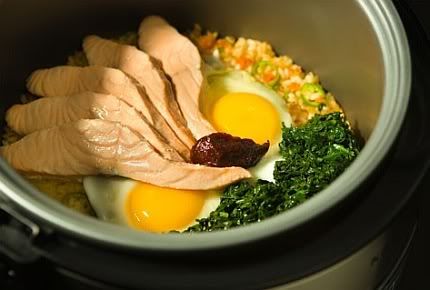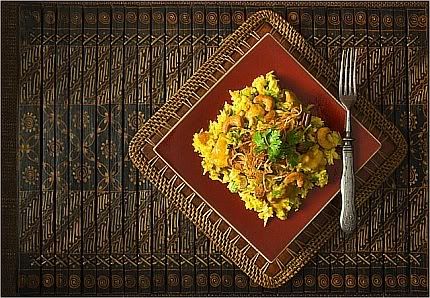La Olla Arrocera.
Dining & Wine |
| The Steamy Way to Dinner By JULIA MOSKIN Published: September 30, 2008 |
 Francesco Tonelli for The New York Times |
| SHIRLEY CHAN, a Chinese-American Web site designer, was born in Hong Kong, lives in Brooklyn, and has never cooked a pot of rice in her life. "One billion Chinese people cannot be wrong about rice," she said: virtually every household has at least a basic rice cooker. As a child, it was her chore before each meal to wash the rice, measure it into the machine, and press the button. "It always, always comes out perfect," she said. "Until I came here, I never even knew rice could burn." Although rice cookers are gaining in popularity in the United States, with a respectable 3 million sold last year, they are still not standard equipment. But American cooks with Asian, Middle Eastern or Caribbean traditions hovering over the kitchen often find them indispensable, and surprisingly adaptable. Domingo Guillen uses his to make vast batches of Puerto Rican arroz con gandules, rice and peas, before a weekly domino game at his apartment in the Inwood section of Manhattan. Fairuza Akhtar, a restaurant owner in Jackson Heights, Queens, who was born in Pakistan, has developed a quick method for making fragrant, creamy biriyani with whole spices and bites of chicken, at home in her rice cooker. "My mother would fall down in a faint," she said, referring to the traditionally reverent attitude toward biriyanis in Northern India and Pakistan. "But rice cookers are the way of the modern world." Ryosuke Tokuji, a graphic design student in Tokyo who lives in a dorm room with no kitchen, does all her cooking in a rice cooker. Like many larger models, hers has a built-in steamer, which she uses for dumplings, savory egg custards (chawan mushi) and fish. Ms. Tokuji has even baked a sweet, buttery loaf of bread in her rice cooker, based on a recipe from a popular television show about a superhero's quest to develop a "national loaf" for Japan. "It took all day, but it was very interesting," she said. Cooking foods other than rice in a rice cooker is like baking a layer cake in an Easy-Bake oven: best approached with patience, curiosity and something to snack on in the meantime. Some people cook in their rice cookers because they have little choice: they live in tiny spaces, or can't afford a stove, or live in sweltering climates where cooking on the stove or in the oven makes the kitchen too hot. But many just can't resist taking their machines out for a spin. John Youngsun Park, a designer of video games in the San Francisco Bay Area, blasts the heat on his Sanyo to make noo roong ji, the toasted crust of rice that forms at the bottom of the traditional Korean stone rice pot. "You just want to see what it can do," Mr. Park said. In fact, it can poach, steam and simmer, as well as turn out a crisp noo roong ji. "People love that toasted-rice taste," he said. "It's even a flavor of ice cream in Seoul." (Japanese cooks, however, consider toasted rice overcooked and highly undesirable. The unwanted crust left stuck to the bottom of the rice cooker is called okoge the same word used as slang for a single woman who spends a lot of time with gay men.) |
 Francesco Tonelli for The New York Times ADAPTABLE Bibimbap with spinach and salmon. |
A basic rice cooker consists of a nonstick metal bowl set inside a plastic-and-metal housing, with a heat source on the bottom. To cook plain rice: add rice, measure water, press start, walk away. The machine brings the mixture to a boil, reduces the heat for a prolonged simmer, then switches to a very low setting to keep the cooked rice at serving temperature. How does the machine know when the rice is done? A built-in thermostat tracks the temperature of the bubbling mixture of rice and water. When the water boils and turns to steam, the temperature in the pot begins to rise, which signals the cooker to switch to warm. But it's easy to override the machine's small brain. Press the "cook" button, melt butter in the bowl, and sweat a finely diced shallot in it until soft then add rice, broth and saffron strands, and start the machine again to make a daffodil-yellow pilaf. Cook some short-grain rice, then drizzle in some sesame oil and switch back to "cook," mix in some kimchi and break eggs on top for a simple bibimbap, the Korean-American staple of rice "and whatever is in the refrigerator," Mr. Park said. Make grits, risotto or any grain cooked by the absorption method simply by adding extra liquid and stirring often. The machine has plenty of built-in cushions for the cook: the temperature never gets very high, the surface is nonstick, and everything happens in a kind of slow-motion. |
 Francesco Tonelli for The New York Times Chicken with basmati rice and cilantro. |
| The first models were sold in Japan in the 1950s, to mimic the shape and slow-cooking method of the traditional Japanese rice pot. Electricity was just becoming widely available in Asia, and the rice cooker was the first appliance designed specifically for an Asian kitchen. It was enthusiastically adopted, especially by the many Japanese women who entered the workforce in the 1950s. The new-model rice cookers, with digital menus and "fuzzy logic" operation, are actually less flexible than their one-button ancestors. The machines have their own ideas about brown rice, porridge, sushi rice and sometimes more. These cookers produce perfect results but require peace and quiet to perform their mystical work. "Fuzzy logic" is a way of describing situations that cannot be described in absolutes: yes or no, true or false, white rice or brown. Fuzzy logic is used in automated technology that must sense and adjust for various factors, like mixing cement (depends on humidity) and changing traffic lights (depends on traffic). In rice cookers, fuzzy logic can take into account the type of grain, its age and hardness and its desired consistency. Frequent rice cooks who work with a variety of grains and have room on the countertop will not be disappointed by the performance of these machines. Inexpensive rice cookers with just two settings can handle many of the same tasks, though they require more attention. A mastery of regular binary logic is quite sufficient to operate these simpler models, but the initial process of measuring the rice and water can be mystifying. There are many recipes for rice cooker dishes, on the Internet and in books like "The Ultimate Rice Cooker Cookbook" (Harvard Common Press, 2002), but many of them are really recipes for steaming, or involve other pots and appliances. The most intriguing recipes are those that have been developed, out of necessity or curiosity, entirely for the rice cooker, like the ones here. Hui Leng Tay, a food blogger in Singapore, is unusually committed to her rice cooker, having developed recipes for fried rice, bibimbap, Thai tom yum rice and many others at teczcape.blogspot.com. She sees herself as seeking the elusive grail of cooks everywhere: the make-ahead, not-too-unhealthy, tasty meal. "I try to figure out which ingredients get better when kept over low heat for a long time, like cabbage and onions, and which ones get droopy," she said. Shabnam Rezaei, an editor and producer, who grew up in Tehran in the 1970s and now lives in New York and Vancouver, said that a fundamental expectation for women in Iran is the ability to make tender, fluffy rice. "There are all kinds of jokes in Farsi about how women must keep their eyes on the rice pot or they will not find a husband," she said. Making Persian rice correctly requires the cook to rinse and soak the grains, parboil them, dump them out, oil the pot, put the rice back and steam it, covered with a towel, until tender and surrounded by a golden crust on the bottom and sides called the tahdig. It is perhaps not surprising that rice cookers, with a built-in tahdig function, have become standard in Iran. "In a culture where rice is so important, such a staple," she said, "the rice cooker can bring a kind of liberation for women." |
| Related
|
| Ratios in Translation Rice cookers are usually sold with a plastic measuring cup that holds about three-quarters of an American cup. It is the size of the traditional Japanese tool for measuring rice: the masu, a wooden box sometimes used for drinking cold sake. "Measuring seems to be the most difficult part for our American buyers," said Marilyn Matsuba, the American marketing manager for Zojirushi, the company that sells the most rice cookers in Japan. She said cooks can use the same proportions as when cooking rice in a pot. A ratio of two cups liquid to one cup long-grain rice will work; for short-grain rice, the ratio of water to rice is about one and a quarter cup to one cup. An Asian measuring method is surprisingly reliable: with the tip of the index finger resting on the top of the rice, add water until it rises just above the first knuckle. A rice cooker can accommodate easygoing approaches to measurement, because its long steam bath evens the texture of the rice. |
| Open article at NYT Web Site. |

0 Comments:
Post a Comment
Subscribe to Post Comments [Atom]
<< Home